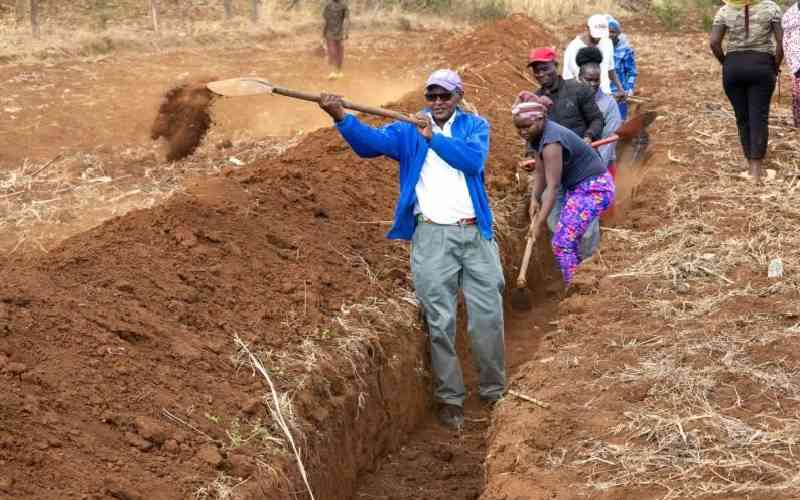Lake Magadi, which has been mined since 1911 for its naturally occurring soda ash, is now under threat due to massive soil erosion upstream in Narok and Suswa.
Since 2005, the amount of silt that has found its way down to the lake has been on the increase, affecting the production of trona, which is the raw material that produces sodium carbonate.
According to Tata Chemicals Magadi managing director, Jackson Mbui, of the 52 square kilometres of mineable area, 14 square kilometres are covered with silt.
“The silt impedes the crystallisation of trona. The crystallisation process is slowed down even further, and even when it occurs, it’s not as pure as it used to be,” he said.
Sodium carbonate, commonly known as soda ash, is used in the manufacture of glass, soap and detergents, as well as for water treatment. It is also used to make salt licks for livestock and in the leather industry.
Joshua Marabui, the mining production team leader at Tata Chemicals, which mines the soda ash at Lake Magadi, said the speed with which the lake is being silted is worrying, especially since it takes about 15 to 25 years for trona to be naturally produced.
Main markets
Tata Chemicals is Africa’s biggest miner and exporter of natural soda ash, with its main markets being India, the Middle East, South East Asia and other parts of Africa.
The company exports about 90 per cent of the 350,000 tonnes of soda ash it mines annually.
China is the largest producer of the mineral at 27 million metric tonnes, against a consumption of 18 million metric tonnes.
Studies estimate that as of 2011, total global demand for soda ash was 52 million metric tonnes, with this figure expected to increase to 65 million metric tonnes by the end of next year.
Soda ash can be produced synthetically, which accounts for about three-fourths of global supply, or from natural mineral resources, which provide about one-quarter of global supply.
The costs of producing natural soda ash are significantly lower than synthetic production, which makes the siltation at Lake Magadi particularly troubling for the country’s soda ash mining sector.
The increase in silt deposits in the lake is said to have been aggravated by the construction of the Narok-Mai Mahiu road, when inadequate culverts were installed to drain storm water.
Rono Victor, a student at the University of Nairobi’s College of Architecture and Engineering, partnered with the Kenya National Highways Authority (KeNHA) and Gauff Hp Consultants to conduct a study on why the road, which was finished in 2011, was damaged by storm water in 2012.
Stay informed. Subscribe to our newsletter
The study found that environmental impact assessment studies that were done prior to the commencement of the road’s construction were not exhaustive enough to ascertain the magnitude of the water that would come down the hills. As a result, the mechanical drainage put in place was not sufficient to handle the volume.
Yearly inspections
In addition, the study questioned the workmanship on the road, and noted that yearly inspections that were to be carried out by a designated roads official were done when there was a problem to solve, rather than being done regularly for maintenance.
At a recent meeting, Kajiado West MP Moses Ole Sakuda also told stakeholders with interests in the lake that a report done on the environmental impact of the road’s construction was wanting.
“In addition to the improper drainage on the road in question, there has been increased deforestation upstream due to search for wood fuels and agriculture,” he said.
“Unfortunately, as much as people are enterprising in trying to fend for themselves food-wise, they are still using poor agricultural practices, leading to the massive soil erosion witnessed.”
Some of the short-term stop-gap measures that Tata has put in place include building gabions to act as a buffer to the silt, which moves at a speed of 8,000 tonnes per hour when there are flash floods.
During a site visit, Business Beat found that most of the gabions have been destroyed by the silt’s velocity as it moves to the lake.
Lake Magadi is at the lowest point of the Rift Valley, being at the bottom of a 100-kilometre gradient from Nairagie Enkare and Suswa areas in Narok County.
Currently, more than a quarter of the mineable area around the lake is covered with silt that is four feet deep on average. Shrubs that traditionally grow upstream in Narok are now growing on the lake.
Deteriorating purity
Mr Marabui said Tata, which operates 24 hours, mines between 950 and 1,200 tonnes of soda ash per day. It transports 90 per cent of its product to Mombasa from Magadi by rail for export.
The Magadi rail has a fleet of eight locomotives and 276 wagons. The 146 kilometres of railway maintained by Tata fall between Magadi and Konza, where the line connects to the main Nairobi-Mombasa railway.
The siltation has affected the purity of the soda ash mined. Purity levels used to be at 99 per cent before deteriorating to 97 per cent, and are now at 95 per cent.
Mr Mbiu said the country is losing out on millions of shillings in revenue as the soda ash produced now fetches less money as a result of its impurities.
Tata has partnered with the Narok County government to distribute tree seedlings to farmers in bid to arrest soil erosion in the county.
With or without the siltation, Kenya is in competition with large producers of natural soda ash, including the United States, China, Botswana and Turkey, as well as synthetic producers, such as India, China and several European countries.
[email protected]
 The Standard Group Plc is a
multi-media organization with investments in media platforms spanning newspaper
print operations, television, radio broadcasting, digital and online services. The
Standard Group is recognized as a leading multi-media house in Kenya with a key
influence in matters of national and international interest.
The Standard Group Plc is a
multi-media organization with investments in media platforms spanning newspaper
print operations, television, radio broadcasting, digital and online services. The
Standard Group is recognized as a leading multi-media house in Kenya with a key
influence in matters of national and international interest.
 The Standard Group Plc is a
multi-media organization with investments in media platforms spanning newspaper
print operations, television, radio broadcasting, digital and online services. The
Standard Group is recognized as a leading multi-media house in Kenya with a key
influence in matters of national and international interest.
The Standard Group Plc is a
multi-media organization with investments in media platforms spanning newspaper
print operations, television, radio broadcasting, digital and online services. The
Standard Group is recognized as a leading multi-media house in Kenya with a key
influence in matters of national and international interest.






